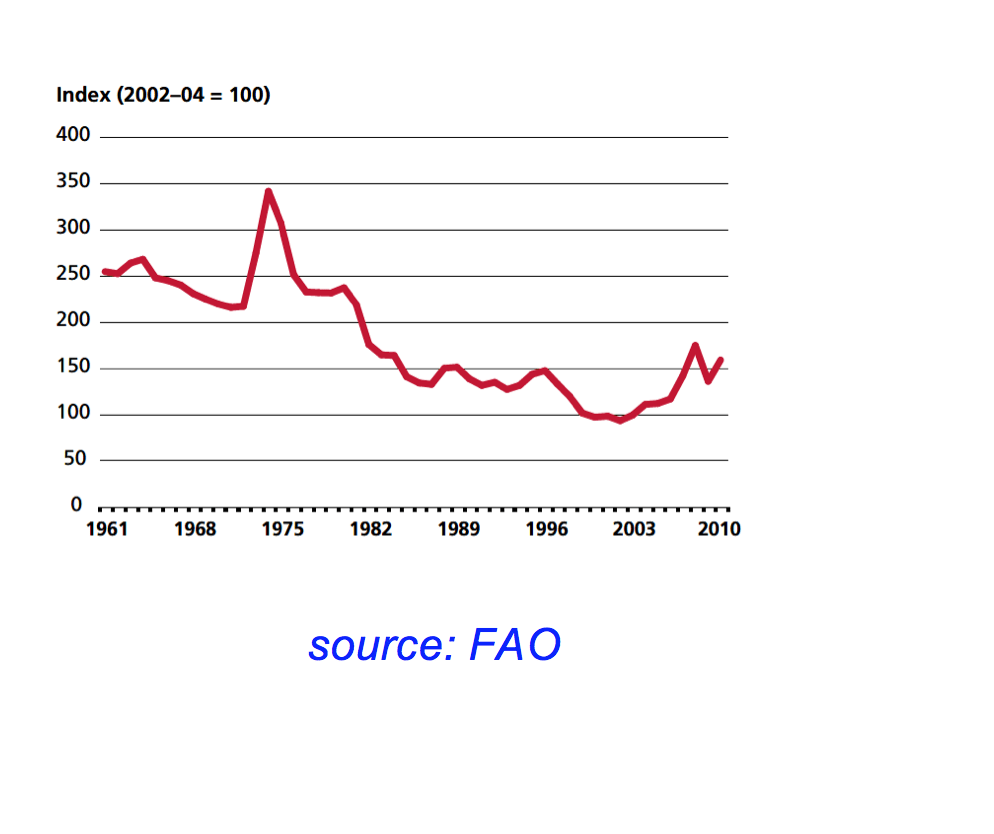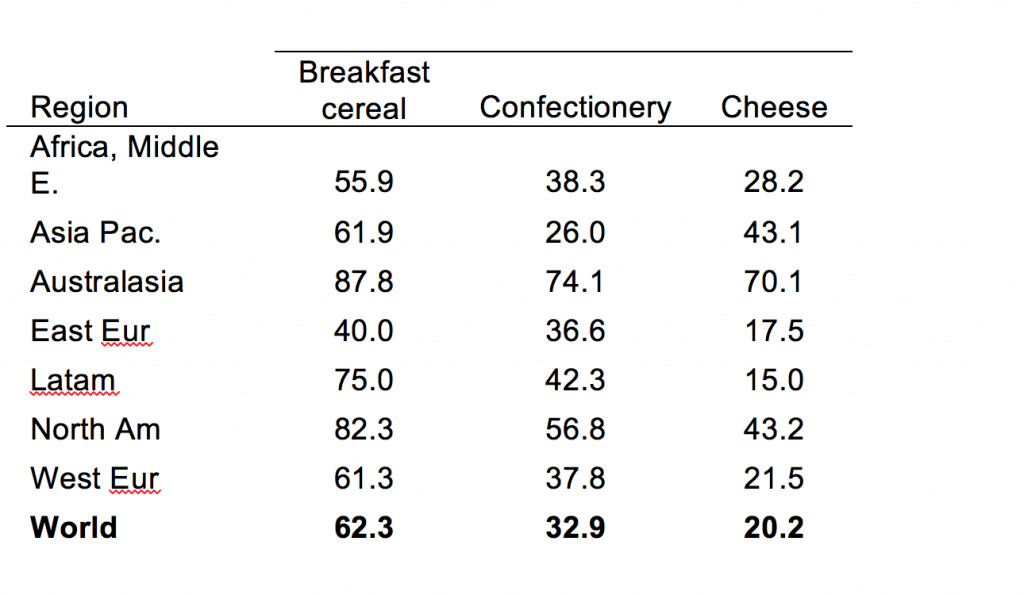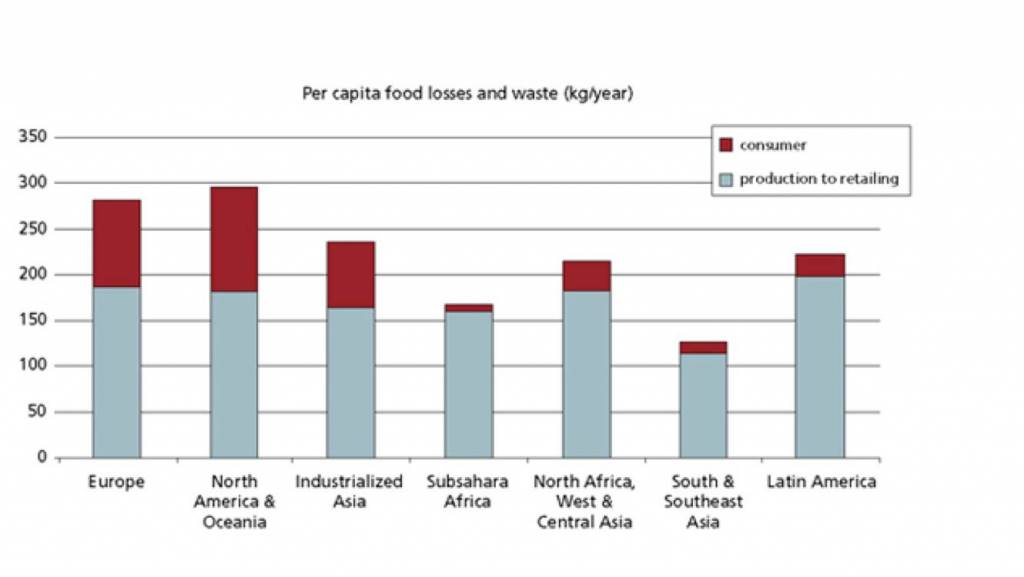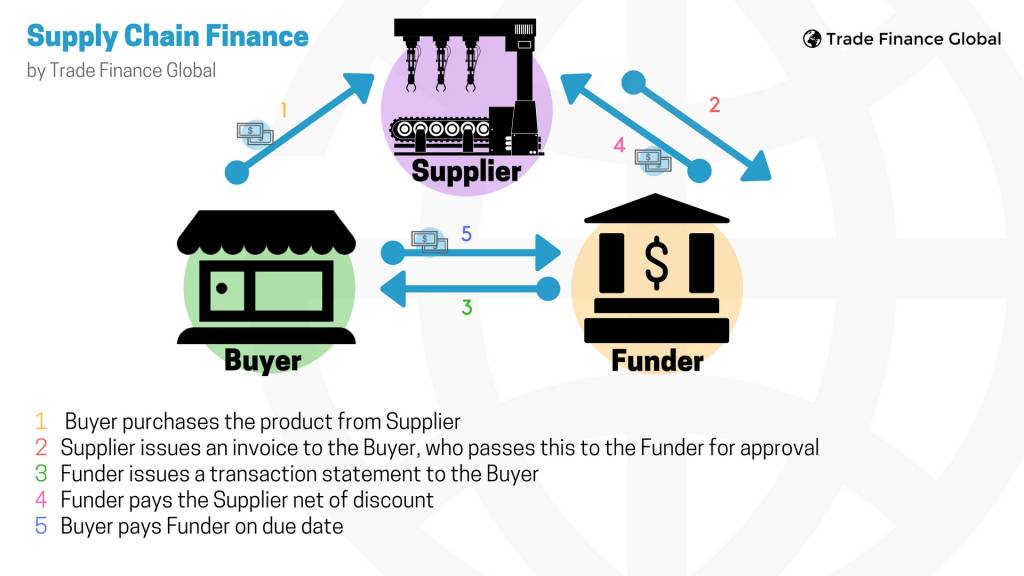The criticism of large firms for various reasons notwithstanding, several small businesses benefit from associating with them. The scale and strength of large firms has spillover effect in providing small businesses the key ingredient for their growth i.e. access to finance at reasonable cost.
Why the criticism?
In the recent years large global agricultural commodity trading companies (such as Cargill & Louis Dreyfus), packaged food companies (such as Nestle & Unilever) and large retailers (such as Tesco & Walmart) have been criticized, for various reasons including but not limited to increasingly lower realizations for the farmers (chart 1), increasing financialization of agricultural output and the corresponding price volatility resulting from trading (chart 2), concentration leading to much reduced bargaining power for their suppliers (chart 3) and encouraging food wastage by promotion of large SKUs (chart 4).




Does it mean David vs. Goliath?
The charts above show only one side of the story. There are several examples of how global firms with all their muscle power have helped develop entrepreneurship, provided access to finance, shared global best practices and helped promote agriculture and small business in general in developing countries such as India as well as in the more developed parts of the world. Some companies such as the German retailer Aldi have been, in a good sense, also been accused by the Reserve Bank of Australia of causing low inflation in Australia.
I make the following table that shows the number of suppliers and distributors of a large global food company- Nestle, in India the basis of our discussion on the role of big firms in local economies.
| Suppliers (nos.) | Distributors (nos.) | |
| Nestle India | 3500 | 1600 |
Source: company presentation at Financial Analysts and Institutional Investors meet on 24th Aug, 2017 from www.nestle.in
Please note that this example is just to provide context and dependence within the supply chain. Later in this note, I have made assumptions concerning Nestle India’s dealings with its suppliers & distributors which may not reflect reality and are merely used to demonstrate potential benefits of being associated with the supply chain of a large company.
Now the interesting question is what does the large supply chain network of these giants mean for the much smaller but large number of suppliers and distributors. In my experience, the biggest contribution of the association with a strong global name such as Nestle and Unilever is the access to finance (and that also happens to be much cheaper than would otherwise be the case) as is explained below. What I am alluding to here is the magic of supply chain finance which you will see unfold in the following discussion.
Most large food companies have highly profitable brands and strong balance sheets and they hardly borrow. Even if they do, they tend to raise capital at lower costs from financial markets rather than from banks.
On the other hand, SME businesses are typically stretched for funding for two main reasons:
- weak balance sheets which make them unattractive borrowers for banks on a stand-alone basis
- long cash conversion cycles- for example, large FMCG (Fast-moving-consumer-goods) companies operate on cash-and-carry terms for their distributors and usually do not pay cash upfront to their suppliers. In effect, small suppliers to large FMCG companies usually end up offering them credit and small buyers/ distributors have to pay cash upfront for their purchases.
Banks normally lend (i.e. provide credit facilities for working capital or long-term funding) to companies on the basis of their balance-sheet/ financial strength, ability & willingness to pay and the availability of ‘security’ in the form of a claim over the assets of a company (land, buildings, furniture & fixtures, inventories etc.). This seems to indicate that a new company must fund its operations from its own capital till it is able to make its balance sheet strong enough to support its funding requirements from banks.
Banks and financial institutions realized this gap long ago and have been funding the “supply chain” of large companies on the procurement and distribution side, in effect providing finance to their suppliers and distributors. This is illustrated using an example below.
There are two ways of dealing with the financing requirements:
- Supply Chain Finance
- Structured Trade Finance
Supply Chain Finance
Some numbers to note (rounded off to keep the discussion simple):
Nestle’s total sales (Jan-Dec 2016): INR 90Bn/ USD 1.5Bn
Nestle’s total purchases (Jan-Dec 2016): INR 75Bn/ USD 1.2Bn
Source: Company annual report for INR figures
Let me take some time to explain the representative profile of Nestle’s suppliers and distributors.
Suppliers: Nestle has 3500 suppliers each supplying roughly USD 0.4Mn each worth of cocoa, milk, sugar etc. Most such suppliers tend to be “exclusive suppliers” to Nestle and can be classified as typical SMEs when it comes to their ability to borrow from banks to increase their business. These are typically family run businesses each specializing in a small part of Nestle’s supply chain and typically do not have much collateral to offer banks for their funding requirements.
However, what distinguishes these SMEs from other small companies is their association with a company such as Nestle- a signal to the lenders that a much bigger brand has placed comfort in the quality of supplies of this small company.
Take a breath before you read on and think of the possible points at which a SME dealing with Nestle will be ‘out-of-cash’ and need working capital financing.
Let us take the case of a milk supplier to Nestle to answer this question. The supplier in turn procures milk from several farmers paying them usually on the day of purchase, stores the milk in specified equipment and then transports milk to Nestle’s local factory. Let us assume that this cycle of procurement, storage and transportation takes a week after which Nestle receives the milk and recognizes this purchase from the milk supplier. Remember, the milk supplier has paid for all the expenses from his pocket for one week now. Again assume, Nestle settles the suppliers bills every 15 days. That means the relatively small milk supplier is using his own capital to run the business for almost 22 days (7 days in procurement, storage and transportation and 15 days in settlement of bills from Nestle).
Next, it is time to drop some good news.
Now, after two years of working with this supplier Nestle realizes that the quality of milk supplied is far better than that of other suppliers at a competitive price (which in other words means the SME milk supplier’s profit margins are low!) and decides to increase the quantity of purchases from this supplier to three times of the current levels.
While it is an excellent business news, the supplier may not be able to increase supplies if he does not have more money to invest in the business. Imagine having to invest triple the money in business for 22 days at low profit margins!
Now is when Supply Chain Finance kicks in. Suppliers need funding to finance their supplies to Nestle.
The Magic of Supply Chain Finance vs The unfavourable status quo
The unfavorable status quo
On a standalone basis banks want to lend to Nestle who doesn’t need the funding. Banks are cautious to lend to SMEs beyond certain thresholds, financial & other parameters. With status quo, the end result is that the supplier (assuming he has already borrowed to the extent banks are comfortable on the basis of their relatively small and possibly weak financial strength) is unable to increase his business with Nestle and Nestle isn’t able to get the best outcome for its business.
A win-win for the supplier, the buyer and the bank
With supply chain finance (and documentation specific to this form of financing), at Nestle’s initiation banks evaluate the relationship the supplier has with Nestle and fund this increased working capital requirement of the supplier. Think about this- assuming that the bank is comfortable with the due diligence done by Nestle on its supplier (ability to continue supplying, past timeliness & quality of supplies, exclusivity of relationship with Nestle etc)- in this sale purchase transaction involving Milk, who is the ultimate payee?
It is Nestle. And wow, it happens to be the same company banks were too willing to lend but they were not too keen to borrow.
Distributors: The same principle would apply on the sales side of Nestle’s business. Each distributor, on average, buys from Nestle and sells products worth USD 0.9Mn. Should Nestle wish to increase their business in India, without committing more working capital, it would need its distributors to buy more material with payment upfront (I have assumed that). Again, SME distributors would find it difficult (if not impossible) to fund their business beyond a point. Banks enable this leg of the business via Supply Chain Finance the same way as they fund Nestle’s suppliers.

This form of financing is what is known by different names such as Supply Chain Finance, Invoice Discounting, Receivables Financing depending on whether one is looking at things from the point of view of the buyer or the supplier.
Next, I move to a brief discussion of Structured Trade Finance and how it can help companies increase their business.
Structured Trade Finance (STF)
What is STF and how is it different from traditional lending by banks?
Structured Trade Finance is the means through which funding is provided outside the traditional fall back on security –the focus shifts from the ‘strength’ of the borrower to the underlying cash flow and structures that enhance safe financing.
What type of underlying goods are funded via STF?
While traditional trade financing aims to finance all types of raw commodities & finished goods (e.g. cotton, paper, shirts, rice, software exports etc) Structured Trade Finance aims to finance high-value domestic & international trade mainly in commodities. Major Commodity groups normally included under STF are: Metals, Energy and Agricultural Commodities.
STF is limited to certain commodities which are highly liquid and financing is done to enhance production, purchase and sale of commodity whereas traditional trade finance is more geared towards mitigating counterparty risk.
The key distinction from any SMEs point of view is that STF helps unlock value from their inventories that the lender could sell if things don’t go as planned! Underlying good dealt with in traditional Trade Finance may or may not have a ready market whereas most goods dealt with in STF are commodities that have an active market and can therefore be sold by the bank easily in case the borrower is unable to pay back.
How does it all work and what is the role of banks?
Under traditional trade finance banks are only responsible for financing against documents whereas under STF goods are directly/indirectly monitored by bank on regular intervals usually through intermediaries such as Collateral or Warehouse Managers and under some structures also have Insurance backing provided by export promotion agencies (such as from Export Import Banks) etc
Under STF, goods are usually in the custody of independent third parties such as an escrow agent, collateral manager and not the borrower (e.g. oil). Under traditional trade finance, goods are in the custody of the borrower (e.g. from raw cotton to the manufacture of shirt).
Under traditional trade finance, the primary recourse for repayment is on the borrower or the bank involved. However, under STF, repayment terms are structured in such a way that the ultimate buyer pays directly to the bank instead of to the seller.
Pockets of value
As the mostly hypothetical example above demonstrates, there are positive spillover effects of being in-the-chain. While making their lending decisions, lenders typically look for ‘skin-in-the-game’. And Nestle does have its skin-in-the-game when it agrees to leverage its balance sheet strength to ensure its supply chain partners also grow and prosper. If you run a small or medium-sized business and haven’t explored supply chain finance yet, we’d always recommend looking into SCF as a way to improve your business’ bottom-line.





























